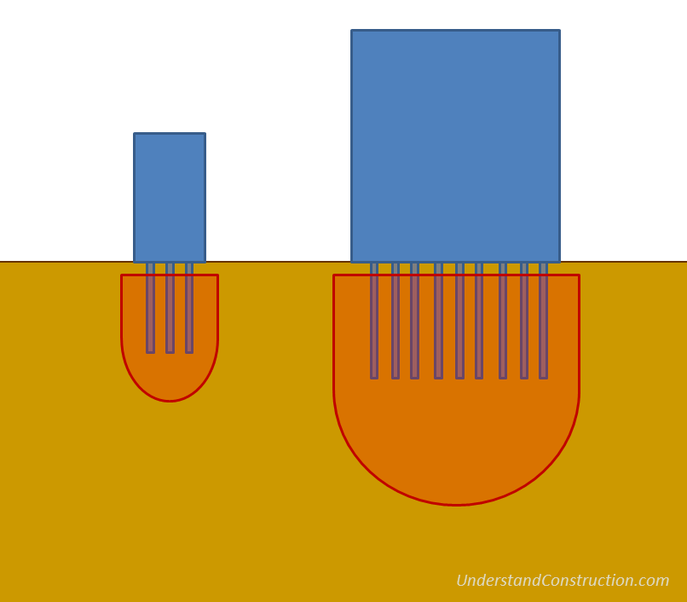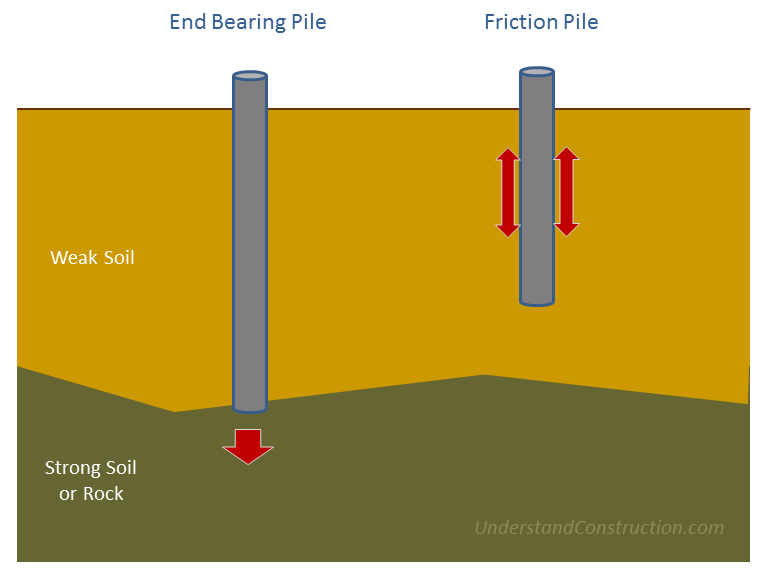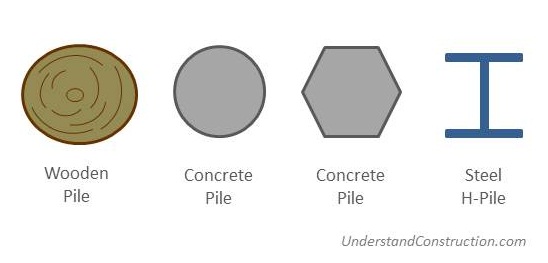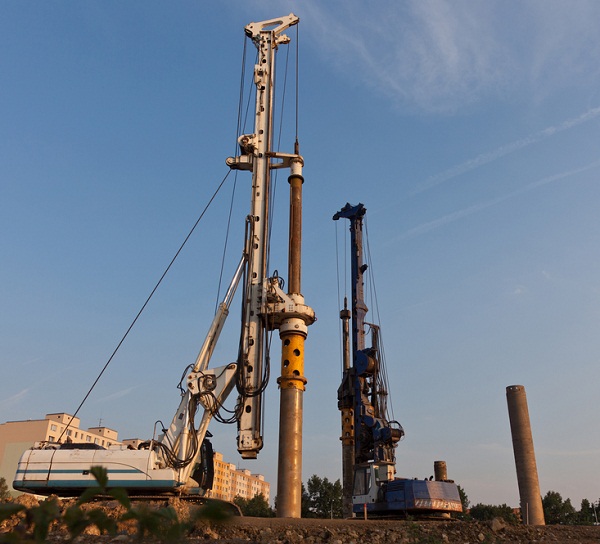TYPES OF FOUNDATIONS
Read our introduction to foundations if you have missed it...(Ishfaq Gulzar)
In this article we will discuss the common types of foundations in buildings. Broadly speaking, all foundations are divided into two categories: shallow foundations and deep foundations. The words shallow and deep refer to the depth of soil in which the foundation is made. Shallow foundations can be made in depths of as little as 3ft (1m), while deep foundations can be made at depths of 60 - 200ft (20 - 65m). Shallow foundations are used for small, light buildings, while deep ones are for large, heavy buildings.
In this article we will discuss the common types of foundations in buildings. Broadly speaking, all foundations are divided into two categories: shallow foundations and deep foundations. The words shallow and deep refer to the depth of soil in which the foundation is made. Shallow foundations can be made in depths of as little as 3ft (1m), while deep foundations can be made at depths of 60 - 200ft (20 - 65m). Shallow foundations are used for small, light buildings, while deep ones are for large, heavy buildings.
SHALLOW FOUNDATION
Shallow foundations are also called spread footings or open footings. The 'open' refers to the fact that the foundations are made by first excavating all the earth till the bottom of the footing, and then constructing the footing. During the early stages of work, the entire footing is visible to the eye, and is therefore called an open foundation. The idea is that each footing takes the concentrated load of the column and spreads it out over a large area, so that the actual weight on the soil does not exceed the safe bearing capacity of the soil.
There are several kinds of shallow footings: individual footings, strip footings and raft foundations.
In cold climates, shallow foundations must be protected from freezing. This is because water in the soil around the foundation can freeze and expand, thereby damaging the foundation. These foundations should be built below the frost line, which is the level in the ground above which freezing occurs. If they cannot be built below the frost line, they should be protected by insulation: normally a little heat from the building will permeate into the soil and prevent freezing.
There are several kinds of shallow footings: individual footings, strip footings and raft foundations.
In cold climates, shallow foundations must be protected from freezing. This is because water in the soil around the foundation can freeze and expand, thereby damaging the foundation. These foundations should be built below the frost line, which is the level in the ground above which freezing occurs. If they cannot be built below the frost line, they should be protected by insulation: normally a little heat from the building will permeate into the soil and prevent freezing.
Individual footings are one of the most simple and common types of foundations. These are used when the load of the building is carried by columns. Usually, each column will have its own footing. The footing is just a square or rectangular pad of concrete on which the column sits. To get a very rough idea of the size of the footing, the engineer will take the total load on the column and divide it by the safe bearing capacity (SBC) of the soil. For example, if a column has a vertical load of 10T, and the SBC of the soil is 10T/m2, then the area of the footing will be 1m2. In practice, the designer will look at many other factors before preparing a construction design for the footing.
Individual footings connected by a plinth beam. Note that the footings have been cast on top of beds of plain cement concrete. (PCC), which has been done to create a level, firm base for the footing.
Individual footings are usually connected by a plinth beam, a horizontal beam that is built at ground or below ground level.
STRIP FOOTINGS
Strip footings are commonly found in load-bearing masonry construction, and act as a long strip that supports the weight of an entire wall. These are used where the building loads are carried by entire walls rather than isolated columns, such as in older buildings made of masonry.
RAFT OR MAT FOUNDATIONS
Raft Foundations, also called Mat Foundations, are most often used when basements are to be constructed. In a raft, the entire basement floor slab acts as the foundation; the weight of the building is spread evenly over the entire footprint of the building. It is called a raft because the building is like a vessel that 'floats' in a sea of soil.
Mat Foundations are used where the soil is week, and therefore building loads have to be spread over a large area, or where columns are closely spaced, which means that if individual footings were used, they would touch each other.
Mat Foundations are used where the soil is week, and therefore building loads have to be spread over a large area, or where columns are closely spaced, which means that if individual footings were used, they would touch each other.
DEEP FOUNDATIONS
PILE FOUNDATIONS
A pile is basically a long cylinder of a strong material such as concrete that is pushed into the ground so that structures can be supported on top of it.
Pile foundations are used in the following situations:
Pile foundations are capable of taking higher loads than spread footings.
There are two types of pile foundations, each of which works in its own way.
Pile foundations are capable of taking higher loads than spread footings.
There are two types of pile foundations, each of which works in its own way.
End Bearing Piles
In end bearing piles, the bottom end of the pile rests on a layer of especially strong soil or rock. The load of the building is transferred through the pile onto the strong layer. In a sense, this pile acts like a column. The key principle is that the bottom end rests on the surface which is the intersection of a weak and strong layer. The load therefore bypasses the weak layer and is safely transferred to the strong layer.
Friction Piles
Friction piles work on a different principle. The pile transfers the load of the building to the soil across the full height of the pile, by friction. In other words, the entire surface of the pile, which is cylindrical in shape, works to transfer the forces to the soil.
To visualise how this works, imagine you are pushing a solid metal rod of say 4mm diameter into a tub of frozen ice cream. Once you have pushed it in, it is strong enough to support some load. The greater the embedment depth in the ice cream, the more load it can support. This is very similar to how a friction pile works. In a friction pile, the amount of load a pile can support is directly proportionate to its length.
In practice, however, each pile resists load by a combination of end bearing and friction.
In end bearing piles, the bottom end of the pile rests on a layer of especially strong soil or rock. The load of the building is transferred through the pile onto the strong layer. In a sense, this pile acts like a column. The key principle is that the bottom end rests on the surface which is the intersection of a weak and strong layer. The load therefore bypasses the weak layer and is safely transferred to the strong layer.
Friction Piles
Friction piles work on a different principle. The pile transfers the load of the building to the soil across the full height of the pile, by friction. In other words, the entire surface of the pile, which is cylindrical in shape, works to transfer the forces to the soil.
To visualise how this works, imagine you are pushing a solid metal rod of say 4mm diameter into a tub of frozen ice cream. Once you have pushed it in, it is strong enough to support some load. The greater the embedment depth in the ice cream, the more load it can support. This is very similar to how a friction pile works. In a friction pile, the amount of load a pile can support is directly proportionate to its length.
In practice, however, each pile resists load by a combination of end bearing and friction.
PILE FOUNDATIONS
A pile is basically a long cylinder of a strong material such as concrete that is pushed into the ground to act as a steady support for structures built on top of it.
Pile foundations are used in the following situations:
Pile foundations are capable of taking higher loads than spread footings.
There are two types of pile foundations, each of which works in its own way.
Pile foundations are capable of taking higher loads than spread footings.
There are two types of pile foundations, each of which works in its own way.
End Bearing Piles
In end bearing piles, the bottom end of the pile rests on a layer of especially strong soil or rock. The load of the building is transferred through the pile onto the strong layer. In a sense, this pile acts like a column. The key principle is that the bottom end rests on the surface which is the intersection of a weak and strong layer. The load therefore bypasses the weak layer and is safely transferred to the strong layer.
Friction Piles
Friction piles work on a different principle. The pile transfers the load of the building to the soil across the full height of the pile, by friction. In other words, the entire surface of the pile, which is cylindrical in shape, works to transfer the forces to the soil.
To visualise how this works, imagine you are pushing a solid metal rod of say 4mm diameter into a tub of frozen ice cream. Once you have pushed it in, it is strong enough to support some load. The greater the embedment depth in the ice cream, the more load it can support. This is very similar to how a friction pile works. In a friction pile, the amount of load a pile can support is directly proportionate to its length.
In end bearing piles, the bottom end of the pile rests on a layer of especially strong soil or rock. The load of the building is transferred through the pile onto the strong layer. In a sense, this pile acts like a column. The key principle is that the bottom end rests on the surface which is the intersection of a weak and strong layer. The load therefore bypasses the weak layer and is safely transferred to the strong layer.
Friction Piles
Friction piles work on a different principle. The pile transfers the load of the building to the soil across the full height of the pile, by friction. In other words, the entire surface of the pile, which is cylindrical in shape, works to transfer the forces to the soil.
To visualise how this works, imagine you are pushing a solid metal rod of say 4mm diameter into a tub of frozen ice cream. Once you have pushed it in, it is strong enough to support some load. The greater the embedment depth in the ice cream, the more load it can support. This is very similar to how a friction pile works. In a friction pile, the amount of load a pile can support is directly proportionate to its length.
WHAT ARE PILES MADE OF?
Piles can be made of wood, concrete, or steel.
In traditional construction, wooden piles were used to support buildings in areas with weak soil. Wood piles are still used to make jetties. For this one needs trees with exceptionally straight trunks. The pile length is limited to the length of a single tree, about 20m, since one cannot join together two tree trunks. The entire city of Venice in Italy is famous for being built on wooden piles over the sea water.
In traditional construction, wooden piles were used to support buildings in areas with weak soil. Wood piles are still used to make jetties. For this one needs trees with exceptionally straight trunks. The pile length is limited to the length of a single tree, about 20m, since one cannot join together two tree trunks. The entire city of Venice in Italy is famous for being built on wooden piles over the sea water.
Concrete piles are precast, that is, made at ground level, and then driven into the ground by hammering - more on that later. Steel H-piles can also be driven into the ground. These can take very heavy loads, and save time during construction, as the pile casting process is eliminated. No protective coating is given to the steel, as during driving, this would be scraped away by the soil. In areas with corrosive soil, concrete piles should be used.
HOW PILES ARE USED
As pile foundations carry a lot of load, they must be designed very carefully. A good engineer will study the soil the piles are placed in to ensure that the soil is not overloaded beyond its bearing capacity.
Every pile has a zone of influence on the soil around it. Care must be taken to space the piles far enough apart so that loads are distributed evenly over the entire bulb of soil that carries them, and not concentrated into a few areas. |
 The load pattern of the piles on the soil surrounding them. This is also called a zone of influence.
The load pattern of the piles on the soil surrounding them. This is also called a zone of influence.HOW PILES ARE CONSTRUCTED
Piles are first cast at ground level and then hammered or driven into the ground using a pile driver. This is a machine that holds the pile perfectly vertical, and then hammers it into the ground blow by blow. Each blow is is struck by lifting a heavy weight and dropping it on the top of the pile - the pile is temporarily covered with a steel cap to prevent it from disintegrating. The pile driver thus performs two functions - first, it acts as a crane, and lifts the pile from a horizontal position on the ground and rotates it into the correct vertical position, and second, it hammers the pile down into the ground.
Piles should be hammered into the ground till refusal, at which point they cannot be driven any further into the soil.
Piles should be hammered into the ground till refusal, at which point they cannot be driven any further into the soil.
SPECIAL PILES
Pile driving is very noisy and causes massive vibrations through the soil. For this reason, it is sometimes difficult to use them in sensitive locations. For example, if an operational hospital or science lab is to be extended, driving piles would cause unwanted disturbance. Their use is also restricted in residential areas in many countries. The vibrations could also cause structural damage to older buildings that are close by. In such situations it is possible to use micropiling orhelical piling, neither of which rely on hammering.
Micropiles or minipiles are small piles that are constructed in the following way:
Step 1: a hole a little larger than the pile diameter and the full length of the pile is dug into the ground using an apparatus like a soil boring machine.
Step 2: a precast concrete pile is lowered or pushed into the hole.
Step 3: a concrete grout is poured into the gap between the pile and the earth.
Helical piles are steel tubes that have helical (spiral) blades attached to them. These can be drilled into the ground, meaning that the pile acts as a giant drill bit, and is rotated and pushed into the ground from above, much like a screw drills into wood. Once the steel pile is driven into the ground, a pile cap is poured on top of the pile to prepare it for the construction above.
Micropiles or minipiles are small piles that are constructed in the following way:
Step 1: a hole a little larger than the pile diameter and the full length of the pile is dug into the ground using an apparatus like a soil boring machine.
Step 2: a precast concrete pile is lowered or pushed into the hole.
Step 3: a concrete grout is poured into the gap between the pile and the earth.
Helical piles are steel tubes that have helical (spiral) blades attached to them. These can be drilled into the ground, meaning that the pile acts as a giant drill bit, and is rotated and pushed into the ground from above, much like a screw drills into wood. Once the steel pile is driven into the ground, a pile cap is poured on top of the pile to prepare it for the construction above.






No comments:
Post a Comment